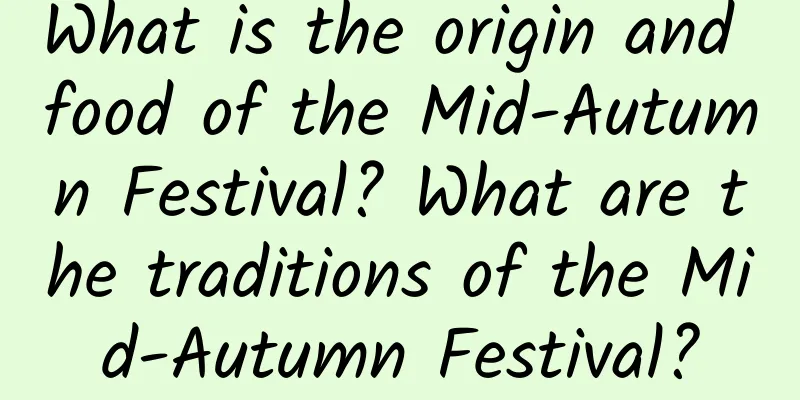What is the origin and food of the Mid-Autumn Festival? What are the traditions of the Mid-Autumn Festival?

|
Eating mooncakes is an essential custom for celebrating the Mid-Autumn Festival in all parts of China. People eat mooncakes on this day to show "reunion". Around the Tang Dynasty, the Mid-Autumn Festival became an officially recognized national holiday. The 15th day of the eighth month of the lunar calendar is the Mid-Autumn Festival. In order to celebrate the harvest, people will prepare many delicacies. Mooncakes are one of the most widely spread traditional Mid-Autumn delicacies. People in the Jiangnan region are popular with eating old pumpkins during the Mid-Autumn Festival. There is a local story of "eating pumpkins in the middle of August". Eating pumpkins during the Mid-Autumn Festival means health and longevity. The 15th day of the eighth month of the lunar calendar every year is the traditional Mid-Autumn Festival. This is the middle of autumn, so it is called Mid-Autumn Festival. When the moon is full during the Mid-Autumn Festival, wanderers far away from home also use this opportunity to express their longing for their hometown and relatives. Let's take a look at the traditions of the Mid-Autumn Festival. Contents of this article 1. The Origin of Mid-Autumn Festival 2. Mid-Autumn Festival delicacies 3. Mid-Autumn Festival traditions 1The Origin of Mid-Autumn FestivalThe Mid-Autumn Festival originated from the worship of celestial phenomena, and evolved from the ancient autumn moon worship. The original "Moon Worship Festival" was held on the "Autumnal Equinox" of the twenty-four solar terms, and was later adjusted to the 15th day of the eighth lunar month. Since ancient times, the Mid-Autumn Festival has included folk customs such as worshiping the moon, appreciating the moon, eating moon cakes, playing with lanterns, appreciating osmanthus flowers, and drinking osmanthus wine. The Mid-Autumn Festival originated in ancient times, became popular in the Han Dynasty, took shape in the early Tang Dynasty, and became popular after the Song Dynasty. The Mid-Autumn Festival is a combination of autumn seasonal customs, and most of the festivals and customs it contains have ancient origins. The Mid-Autumn Festival is one of the four major traditional festivals in China, along with the Spring Festival, Qingming Festival and Dragon Boat Festival. Influenced by Chinese culture, the Mid-Autumn Festival is also a traditional festival in some countries in East Asia and Southeast Asia, especially for local Chinese and overseas Chinese. According to the Chinese calendar, the eighth month of the lunar calendar is in the middle of autumn and is the second month of autumn, called "Mid-Autumn". The fifteenth day of the eighth month is in the middle of "Mid-Autumn", so it is called "Mid-Autumn Festival". 2Mid-Autumn Festival FoodThere are many traditional Mid-Autumn Festival delicacies, such as moon cakes, osmanthus cakes, snails, glutinous rice cakes, water chestnuts, osmanthus wine, hairy crabs, ducks, etc. The 15th day of the eighth month of the lunar calendar is the Mid-Autumn Festival. In order to celebrate the harvest, people will prepare many delicacies. Moon cakes are one of the most popular traditional Mid-Autumn Festival delicacies. Mooncakes are round like the moon and contain various fillings. The main ingredients are flour, eggs, sugar, etc. It has a long history and the earliest existing document was recorded in "Dream Lianglu" by Wu Zimu in the Southern Song Dynasty. Eating glutinous rice cake during the Mid-Autumn Festival originated in the Spring and Autumn Period and the Warring States Period. It is a traditional custom that people started to commemorate the Chu State general Wu Zixu. Glutinous rice cake symbolizes good luck and reunion. It is popular for people in the Jiangnan region to eat old pumpkins during the Mid-Autumn Festival. There is a local story about "eating pumpkins on August 15th". Eating pumpkins during the Mid-Autumn Festival symbolizes health and longevity. 3Mid-Autumn Festival TraditionsThe Mid-Autumn Festival has been a traditional festival for the Chinese people since ancient times. It originated from the worship of celestial phenomena and evolved from the ancient autumn moon worship. The Mid-Autumn Festival, also known as the Moon Festival, Moonlight Festival, Moon Eve, Autumn Festival, Mid-Autumn Festival, Moon Worship Festival, Moon Goddess Festival, Moon Festival, Reunion Festival, etc., originated from the worship of celestial phenomena and evolved from the autumn evening moon worship in ancient times. During the Mid-Autumn Festival, there are few clouds and fog, and the moonlight is bright and clear. In addition to a series of activities such as moon-watching, moon-worshiping, eating moon cakes and wishing for family reunion, some places also hold activities such as dancing grass dragons and building pagodas. The Mid-Autumn Festival, with the roundness of the moon symbolizing family reunion, is a way to express longing for hometown and loved ones, and to pray for a good harvest and happiness. It has become a rich and precious cultural heritage. |
Recommend
How to improve egg quality at the age of 43
Generally speaking, as women age, the quality of ...
[Medical Q&A] How do “diabetic moms” manage their blood sugar after childbirth?
Planner: Chinese Medical Association Reviewer: Zh...
What should I do if I haven’t gotten pregnant after two years of trying?
If a couple has been preparing for pregnancy for ...
How to relieve menopausal loss of appetite
When female friends reach a certain age, they wil...
How much does a pregnancy-preserving injection cost?
Many female friends need to go to the hospital fo...
Is the pain in the middle of the lower abdomen due to the uterus?
Many people have pain in the middle of their lowe...
What is the cause of the early gestational sac?
In the early stages of pregnancy, women's ges...
The more frequently you cut your hair, the faster it grows? Here’s how to take care of your hair scientifically:
"The more often you cut your hair, the faste...
Pharmacist's Antidote | What to do if you have tinnitus? This article will give you a detailed understanding of subjective tinnitus
Xiao Li is a white-collar worker in a company. He...
What is the reason for bleeding just after menstruation?
Some people will have sex right after their menst...
In Q2 2024, the global flexible OLED panel market shipments reached 160 million pieces, a significant increase of 39.9% year-on-year
In the second quarter of 2024, the global flexibl...
Is the new coronavirus a "super mutation"? A picture to understand "Omicron"
Recently, the new coronavirus variant "Omicr...
Does intrauterine adhesion surgery require hospitalization?
After the surgery for intrauterine adhesions, you...
Why are the vulvar bumps not painful or itchy?
Sometimes, abnormal conditions will occur in the ...
Beauty and skin care tips, Chinese medicine whitening and freckle removal tips
Female friends all hope to have fair and moist sk...









